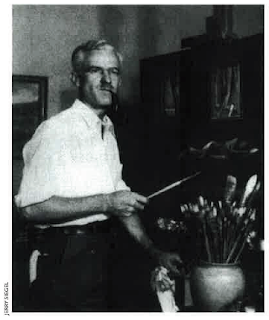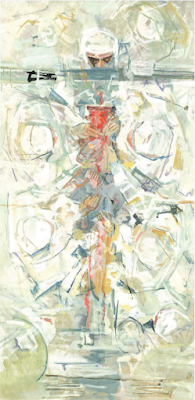On this 20th anniversary of Lamar Dodd's passing, we wish to honor his legacy by sharing with our readers a memoir by William U. Eiland, director of the Georgia Museum of Art. Originally published December 1996 in University of Georgia Magazine.
Lamar Dodd's Odyssey, 1909–1996: A Southern Artist Who Sought Majesty and Truth in the Extraordinary and the Commonplace
 |
| Lamar Dodd, Self Portrait, 1936 |
One of Lamar Dodd's finest paintings is based on a scene he saw not long after his arrival in Athens to join the faculty of the University. Never one to analyze his works in theoretical terms, Dodd always said that any social or political content to his art was in the eyes of the beholder rather than in the mind of the creator. And, thus, when he saw a group of women and children scavenging in the city dump, he decided to describe, to remember, what he had seen in pictorial terms. A cloud of mist or smoke hangs over the scene, the circular forms mirroring the activity below, where women bend and scrabble for life's necessities amongst other people's refuse. As Dodd later appreciated, the picture calls to mind T. S. Eliot's lines, "The worlds revolve like ancient women gathering fuel in vacant lots."
As much as Carr's Hill and the historic North Campus of the University, Dodd's world was equally the city dump, the North Georgia mountains, or his own backyard, where the loveliness of a late-blooming rose sent him scrambling for his watercolors. Elbert Hubbard remarked in the Roycroft Dictionary and Book of Epigrams of 1923, that "Little minds are interested in the extraordinary; great minds in the commonplace." In his career, Lamar Dodd sought the majesty, the truth, in both.
Influenced by LaGrange and New York
 |
| Lamar Dodd, 1995 |
Born on Sept. 22, 1909, in Fairburn, Dodd's first world was the small town of LaGrange, where he studied art at the women's college and where he painted and drew over and over again a lone oak tree and a boat, an image that remained with him for his entire life. Eventually, he went to the Art Students League in New York, where he studied with men and women who were defining American modernism. As early as 1933, with an acclaimed one-man exhibition in Manhattan, he added his voice to those who were seeking meaning through art. His response was in concert with the Agrarians at Vanderbilt University, who argued loudly that Southern artists must look to the rural traditions of the South for suitable subject matter; with the Ashcan artists who argued that the 19th-century academic traditions were obsolete in the 20th century; and the American scene painters, who stridently demanded an American art, one that looked not toward Europe but toward home for inspiration. When he and his wife moved to Birmingham, and as his national stature grew, Dodd became an apostle of this regionalist gospel. His world had now become, once again, the one he loved best: the South, whether the rolling hills of Alabama, the red dirt of Georgia, the tenement houses and cotton pickers and midnight carnivals he sketched and painted and proselytized for, because of the "nearness of their beauty," as he explained to James Saxon Childers. He found in the very air he breathed a challenge to translate it, and he admitted that his inspiration in painting the steel mills of Birmingham was an attempt to capture in paint the "smog that hung like a veil" over the city.
 |
| City Dump, 1939 |
A reviewer of his one-man exhibition in New York characterized Dodd's preoccupation with the everyday sights of the South by noting that the show contained "Not one scene of the Scottish moors with their purple heather. But a glorious painting of the washwoman hanging out the clothes. Not one scene of the fountains of Rome! But a magnificent thing showing the cabins of the tenant farmer. Nothing of Paris or London or Athens or Pompeii. But Georgia, Georgia, Georgia."
Dodd: South no cultural wasteland
And Georgia would be his next destination. By 1937, Dodd, Conrad Albrizio, Anne Goldthwaite, and a very few others, had served notice that the South was no cultural wasteland, that a growing community of Southern artists were fully engaged in the world of New Deal American artistic inquiry. Dodd received a letter from Hugh Hodgson of the School of Fine Arts at the University of Georgia, who invited the young painter, then 28 and without a formal degree, to join the faculty as artist-in-residence. The letter also held the astonishing news that, should he accept the offer, the annual budget for the visual arts program would be raised from $50 to $5,000. The invitation caused consternation in Birmingham, where Childers published in the paper a tongue-in-cheek refusal to give Hodgson a good recommendation of Dodd for the post, because Georgia's gain would be Alabama's irreparable loss.
 |
| LaGrange Hillside, 1927 |
The University joined a group of progressive colleges and universities in hiring leading American painters to act as artists-in-residence, without regard to higher degrees. Dodd was to give example and instruction to students as a practicing, professional artist of note, who was expected to "interest all students with the value of understanding the arts and developing taste so that this institution might serve more faithfully in influencing culturally the people of our state."
The University found itself in 1937 with just such men in the persons of Hodgson and Dodd, who set about consolidating the three teachers, scattered in various departments across campus, into a recognizable department of art, with its own budget — the promised $5,000 — its own building and, most important, students. Nine enrolled as art majors after only one year, and a graduate program was established within the next three years. Dodd's world now became an academic one, but not one confined by walls of ivory.
Student artists popped up everywhere
 |
| Dodd at work, 1945 |
Dodd became a force in the community as well. Athenians saw students sketching on Carr's Hill, designing products for local businesses, cajoling patrons to buy their works at auctions. Other artists of note arrived, lured to Athens by Dodd: Elaine de Kooning, John Held, Yasuo Kuniyoshi, Howard Thomas, Ferdinand Warren, and Carl Holty among them. Dodd had inherited an untenable situation, one he moved to rectify through a rational administrative structure. With the force of his singular personality, combined with an obstinate and almost ruthless commitment to his vision, Dodd cut through red tape and created a real department of art. Chances of success were slim: a studio in a dirt-floor basement, few slides available for teaching, and an insufficient budget. From these modest beginnings, Dodd forged one of the largest art schools in the Southeast, one that boasted at his retirement more than 700 majors, a faculty of 53, a "real" slide library, and a complex of buildings.
 |
| Lamar Dodd, Alfred Heber Holbrook, ca. 1948–49 |
Support craftsmen are artists, too
Dodd was dedicated to the idea that a school of art must include the arts that until recently were defined as "support crafts, minor, or decorative." Thus, he recruited ceramicists, metalsmiths, fabric artists, and interior designers to join the more traditional painters, sculptors, printmakers, and draftsmen. The department grew and prospered through his tenure such that his contributions were recognized in 1996 when the School of Art was named after him. Of all the honors he received, the Lamar Dodd School of Art was the most personal, the most cherished, for it signified that his devotion to students would be forever remembered.
 |
| Lamar Dodd, Old Botanical Gardens, Athens, 1938 |
Cultural ambassador for the U.S.
 |
Lamar Dodd, Open Heart
Surgery, 1979–81 |
During his years at the helm of the department, Dodd helped to found the Georgia Museum of Art. In the 1950s, his world once again expanded with his first trips to Europe to study the Old Masters he revered and later in the 1960s as a cultural ambassador for the nation on state department-sponsored trips to Russia, Turkey, India, Korea, China, and Japan. For a time, Dodd's national stature as an administrator eclipsed his reputation as an artist. He was the first artist — and one without an earned degree — to serve as president of the country's largest and most influential professional organization for those working and teaching in the visual arts: the College Art Association. He traveled and lectured extensively on behalf of Phi Beta Kappa. And no matter how far away from Athens, he kept in his breast pocket his long-range plan for the department of art. People in far-flung corners of the world who had never heard of Georgia knew the goals of the university's department of art. Lamar Dodd wore all these hats, those of administrator, advocate, ambassador, and teacher, with equal commitment, but the one he favored most was that of artist. No matter how busy or preoccupied, he found time to sketch, to draw, to paint. His art underwent stylistic, even technical changes, as he reacted to the new vocabularies of the cubists, the abstract expressionists, the neorealists, or any of the host of voices who clamored to be heard in the polyglot 20th-century aesthetic din. Yet even at his most abstract or decorative, he never stepped over into complete nonrepresentation, because, as he remarked over and over, his art was dependent on the natural world. Pure formalism, which he found sterile and cold, a neo-academicism as it were, was the one voice to which he refused to listen.
 |
| Lamar Dodd, Turkish Bazaar, No. 2, 1995 |
New vistas: NASA and heart surgery
Dodd had to find new means of expression to depict the cosmos when he joined NASA's coterie of artists asked to document America's early adventures in space. His response was to fashion an art of elemental symbols, one where silver and gold emphasized the otherworldly preoccupations of scientists and artists alike. A decade later, in the 1970s, he used similar means to define another, more intimate universe: the surgical amphitheater, one that necessitated an equally novel language of sign and symbol to articulate deeply spiritual concerns about life and rebirth. In the last decade of his life, ever curious, ever impatient with infirmity, he found his subjects on the television screen or in newspapers. Restricted by illness to the community he loved, he searched his own backyard for inspiration, and found it in sunflowers, blades of grass, fossils, and, perhaps most important, in memories of the golden hillsides of Umbria, the glistening masts of sailing ships on the Bosporus, and the multicolored fantasy that is Jaipur. His drawings of this last period retain the vigor, the excitement, the surety of his first sketches of that lone oak tree and boat back in LaGrange. In the last year of his life, Dodd saw both the school of art and a new chair of art in the Athens-Clarke County School System named in his honor, a new museum building with a Lamar Dodd gallery, a major retrospective of his works from 1922 to 1996, and two books about his life and career. One day short of his birthday, he died, but the entire year had been his fellow Georgians' gift to him. The final world, therefore, for Lamar Dodd, teacher and artist, was the most important one: home.




























